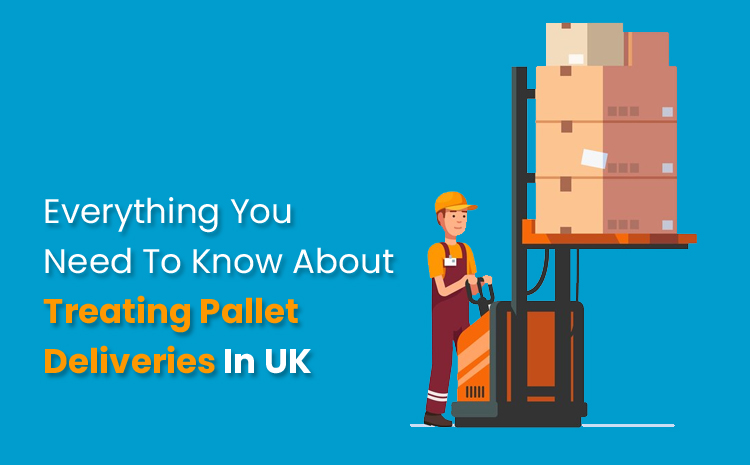If you’re looking for dependable pallet deliveries in UK, this is the right place. You can trust SAV Logistics to deliver the best results!
You may think shipping wooden pallets is a simple task, but do you know how the pallets you send are treated? You should know that not all pallets are the same, and treating your pallets properly is crucial.
Untreated pallets risk being unsafe for the recipient or being rejected and destroyed by the destination country.
So, how can you learn more about how your pallets are treated? Read our guide to find out everything you need to know about pallet treatment.
First Off, Let’s Talk About Treatment Before Pallet Deliveries In UK
Pallet treatment is all about ensuring wooden pallets are free of bugs and ready for international shipping. It is the very first step of pallet deliveries in the UK.
This involves sanitising a pallet with chemicals or heat to eliminate any insects or plants that may be stuck to the pallet. This prevents invasive species from spreading to other countries and keeps your pallets as hygienic as possible.
Why Is It Important To Treat Pallets?
Let us examine why it matters so much before looking at how to determine whether a pallet has been treated. You should use treated pallets for domestic and international shipping for several reasons.
Reason 1# Shipping Pallets To The EU After Brexit
Since the UK left the EU in 2021, it has had to follow the ISPM 15 regulations that control wooden pallets and prevent the spread of harmful bugs and diseases.
All pallets that go in or out of the UK must meet these requirements:
- Wood packaging material must have no bark on it
- Pallets must be either heated or sprayed with pesticides
- Pallets must have a clear mark of compliance, including certain certifications and a 2-letter code to show how the pallet was treated
- Any pallets may be inspected when they enter a country to ensure they follow the ISPM 15 rules
- Pallets that don’t follow the rules can be stopped from entering the country or even destroyed
Reason 2# Overall Safety Of The Pallets
You want your pallets to be clean and safe and safety is essential! Whether in a warehouse or at your customer’s place, you want to ensure that no one gets hurt by your pallets. Pallets that are not treated may have plants and bugs on them, and the extra moisture over time could make your pallet weaker and less reliable.
How To Determine Pallet Wood Treatment? (International Codes)
Knowing what to look for when checking a pallet for treatment is easy. To begin with, you should become familiar with the distinct stamps, markings, and visual cues that denote the type of treatment—if any—your pallet has received.
Look For The IPPC Stamp
When a pallet is shipped outside the UK, it must have a stamp from the IPPC (International Plant Protection Convention) showing it is safe. Next to this stamp, some letters will indicate how your pallet was cleaned.
Sometimes, you may see more than one cleaning marking on your pallet. This just means that your pallet went through several cleaning processes!
Debarked Sign
One pallet you should be aware of is debarked pallets, which have the letters ‘DB’ on your pallet. These pallets are made from wood that has no bark on it. The bark of the tree is removed from all parts of the pallet.
This is done as the first step of pallet treatment and ensures that other forms of pallet cleaning can be applied directly to the wood of the pallet without any bark interfering.
Look For Heat Treated Pallets
A pallet that has been heat treated has been exposed to a temperature of at least 56°C for 30 minutes or more. This helps eliminate pests, improve durability, and make the pallet fit for international shipping according to ISPM 15 rules.
In the case of pallet deliveries in UK, you can tell if your pallet has been heat-treated by looking for an ‘HT’ mark on the wood. Usually, these are in the corners of the pallet, but you should check everywhere, as sometimes it can be hidden or faded!
Pallets Dried On Kiln
Like heat-treated pallets, a kiln-dried treatment also involves heating the wood for a while. But the aim here is to lower the pallet’s moisture and remove pests and plants from it. Pallets are stacked inside large heating chambers (Kilns) and then gradually heated until all the extra moisture is gone.
This type of treatment has the letters ‘KD’ on your pallet. But this is often combined with ‘HT’ to show that your pallet is dry and free from invasive species and can be shipped internationally!
Fumigated Pallets
Another way to treat the pallets is to spray them with chemicals such as Methyl Bromide (MB) or Sulfuryl Fluoride (SF). This is done because some invasive species on the pallet can resist the heat and still live, so pesticides are used to kill all bugs and plants. These are marked with the letters ‘MB’ or ‘SF’ on the pallet.
It is advised to be careful when handling these pallets, as they can be harmful when you breathe in the fumes. You should not use these pallets for personal use or in fires, as they could cause damage.
SAV Logistics – The Ultimate Destination For Safe Pallet Deliveries In UK!
SAV Logistics has provided many customers with a comprehensive array of dedicated courier services for many years. Our garment logistics company offers pallet deliveries in UK, same-day courier services, and exclusive hanging garment transport.
Investing in the right technology can make your delivery operations more efficient. Our expert logistics team will discuss your delivery goals and help you choose a vehicle to accommodate your package.
Contact us today if you want to give our courier services a chance and do pallet deliveries in UK effectively and efficiently!


